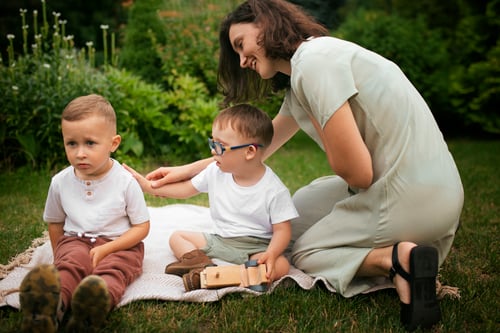During the COVID-19 pandemic, wearing masks was necessary daily to protect oneself and others from infection. However, some worry that wearing masks makes communicating or reading other people’s emotions difficult.
As caregivers, teachers, and parents were also wearing masks during this period, there were concerns about whether masking would affect children’s ability to learn how to communicate and read faces. Will this hurt their language development?
Will parents and teachers wearing masks cause delays in children’s language development?
Some people argue that wearing masks makes it difficult for toddlers still learning language and emotion to see the mouths and expressions of others. Infants typically start babbling around 6 to 8 months old[1]. They spend a lot of time watching the mouths of those who speak to them, not just for auditory cues but also for visual ones. However, this concern is unwarranted. Using masks will not affect a child’s emotions and language development.
Sounds, gestures, and overall body language are all accounted for when children listen to others speaking[2]. When others wear masks, children can still read their facial expressions. No substantive evidence exists that wearing masks hurts children’s language and language development[3]. For example, children with visual impairments have been found to have the same rate of language and linguistic abilities as their age-matched peers[4].
Can children use other cues, such as sound and body expressions, to understand the feelings of others?
Even though facial expressions and lip shapes are not visible with masks on, children will start observing other cues to understand and learn languages. Studies have found that two-year-olds could still understand what masked adults were saying[4]. Findings show that while other people wearing masks may present some challenges, masks are unlikely to significantly affect children’s social interactions in their daily lives when combined with other contextual cues. When one sense is deprived, other senses may be enhanced. Children in general will find ways to communicate and use other cues to understand and learn by looking at gestures, listening to changes in tone deciphering the content of speech, and reading emotions in the eyes.
What are some tips for communicating with children while wearing masks?
Before speaking to a child, get their attention first. Face the child directly, making sure nothing is blocking their view. Speak slowly and at a slightly higher volume (but not shouting) with distinct intonation. Use eyes, hands, body language, and tone to emphasize your message. Ask the child if they understand and repeat words and sentences if necessary. It also helps to reduce environmental noise and distractions.
How can language delays be identified? How important is it to understand language development milestones?
If a child has not reached their age-appropriate language development milestones, they may be classified as having a language delay. They should have developed the following language skills by these specified ages[5]:
- 1 to 1.5 years: Able to say everyday words like “mama”.
- 2 years: Able to combine words, such as “ride car” and “eat cake”.
- 2.5 years: Able to say more words and communicate in whole sentences. Will be able to start asking questions.
- 3 years: Able to say their name and age. Able to talk about everyday occurrences with simple sentences.
- 4 years: Can start understanding stories and comprehend detailed retellings. Asking more questions, especially “why?” Can identify the relationship between events and ask why one event might lead to another.
- 5 years: Can start to understand jokes and riddles. Will start drawing connections between stories and patterns. Start comprehending concepts like cause and effect.
Should parents worry if their child demonstrated signs of delayed language development?
Delayed language development is the most common type of developmental delay. One in five children will take longer to learn to talk or use words than their peers. Some may start having behavioral issues if they become frustrated when they cannot express their needs or wants.
Delayed language development can sometimes be a warning sign of other more severe issues such as hearing impairment, other areas of developmental delay, or even Autistic Spectrum Disorder (ASD). Language delays in early childhood can also indicate learning problems that may not be diagnosed until school age. It is crucial for parents who are concerned about their child's language development to have their development assessed. However, language delays may also be temporary and some cases can be resolved independently or with family members' help. Encouraging a child to "talk" with parents with gestures or sounds is essential. Parents should spend a lot of time playing, reading and talking with their children. In other cases, some children may need the help of a speech therapist to learn to communicate. If the parents suspect their child's language development is abnormal, they should not hesitate to consult a professional. You can seek help from an expert to perform a preliminary screening through a mother and child health center, paediatrics or even your family doctor.
OT&P provides speech therapy services for children, targeting language delays, articulation and oral motor skills, reading difficulties, literacy, and more. Please do not hesitate to contact us for an appointment.
Reference
1. Mayo Foundation for Medical Education and Research. (2022, December 22). Infant development: Milestones from 7 to 9 months. Mayo Clinic. Retrieved February 7, 2023, from https://www.mayoclinic.org/healthy-lifestyle/infant-and-toddler-health/in-depth/infant-development/art-20047086
2. Clough, S., & Duff, M. C. (2020, July 21). The role of gesture in communication and cognition: Implications for understanding and treating neurogenic communication disorders. Frontiers. Retrieved February 7, 2023, from https://www.frontiersin.org/articles/10.3389/fnhum.2020.00323/full
3. Serrano, J. F. (2022, March 4). Do masks for young children impede their language development? The Washington Post. Retrieved February 7, 2023, from https://www.washingtonpost.com/health/2022/03/05/baby-masks-slow-to-speak/
4. Pijnacker, J., Vervloed, M. P. J., & Steenbergen, B. (2012, November). Pragmatic abilities in children with congenital visual impairment: an exploration of non-literal language and advanced theory of mind understanding. Journal of autism and developmental disorders. Retrieved February 7, 2023, from https://www.ncbi.nlm.nih.gov/pmc/articles/PMC3474910/
5. Developmental milestones - child development centre. Child Development Centre - Igniting Learning Journeys. (2016, February 25). Retrieved February 7, 2023, from https://www.cdchk.org/get-tips/developmental-milestones/
 Central General Practice
Central General Practice
 Repulse Bay
Repulse Bay
 Clearwater Bay
Clearwater Bay
 BodyWorX Clinic
BodyWorX Clinic
 Central Specialist Clinic
Central Specialist Clinic
 MindWorX Clinic
MindWorX Clinic
 Partner Clinics
Partner Clinics
 Family Clinic
Family Clinic
 OT&P Annerley Midwives Clinic
OT&P Annerley Midwives Clinic





